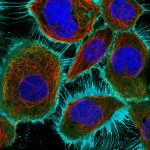Lien vers Pubmed [PMID] – 23012232
Cytoskeleton (Hoboken) 2012 Nov;69(11):893-912
Phosphoinositides [Phosphatidylinositol (PtdIns), phosphatidylinositol 3-monophosphate (PtdIns3P), phosphatidylinositol 4-monophosphate (PtdIns4P), phosphatidylinositol 5-monophosphate (PtdIns5P), phosphatidylinositol 3,4-bisphosphate (PtdIns(3,4)P(2) ), phosphatidylinositol 3,5-bisphosphate (PtdIns(3,5)P(2) ), phosphatidylinositol 4,5-bisphosphate (PtdIns(4,5)P(2) ), and phosphatidylinositol 3,4,5-trisphosphate (PtdIns(3,4,5)P(3) )] are lowly abundant acidic lipids found at the cytosolic leaflet of the plasma membrane and intracellular membranes. Initially discovered as precursors of second messengers in signal transduction, phosphoinositides are now known to directly or indirectly control key cellular functions, such as cell polarity, cell migration, cell survival, cytoskeletal dynamics, and vesicular traffic. Phosphoinositides actually play a central role at the interface between membranes and cytoskeletons and contribute to the identity of the cellular compartments by recruiting specific proteins. Increasing evidence indicates that several phosphoinositides, particularly PtdIns(4,5)P(2) , are essential for cytokinesis, notably after furrow ingression. The present knowledge about the specific phosphoinositides and phosphoinositide modifying-enzymes involved in cytokinesis will be first presented. The review of the current data will then show that furrow stability and cytokinesis abscission require that both phosphoinositide production and hydrolysis are regulated in space and time. Finally, I will further discuss recent mechanistic insights on how phosphoinositides regulate membrane trafficking and cytoskeletal remodeling for successful furrow ingression and intercellular bridge abscission. This will highlight unanticipated connections between cytokinesis and enzymes implicated in human diseases, such as the Lowe syndrome.

